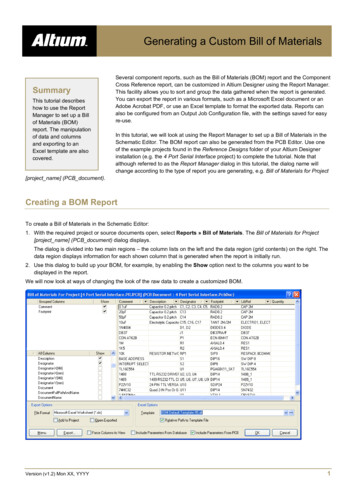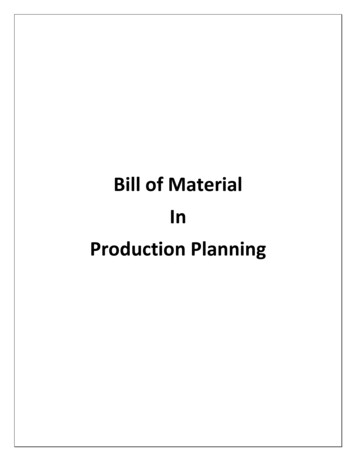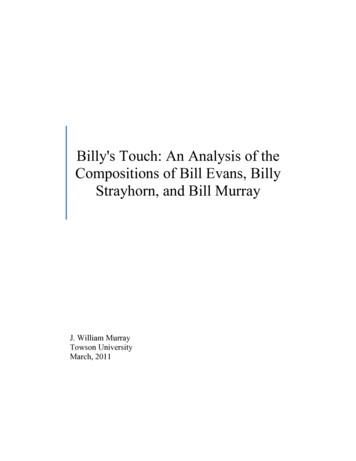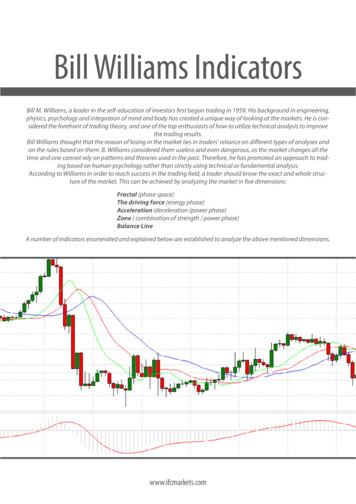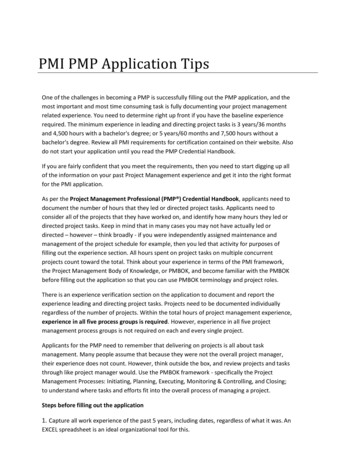
Transcription
TRADE OFPipefittingPHASE 2Module 3Pipe ProcessesUNIT: 3Bill of Materials
Produced byIn cooperation with subject matter expert:Finbar Smith SOLAS 2014
Module 3 – Unit 3Bill of MaterialsTable of ContentsUnit Objective . 1Learning Outcome . 21.0Introduction to Bill of Materials (BOM) . 31.1 Bill of Materials . 31.2 Purpose of the Bill of Materials . 32.0Information Recorded on the Bill of Materials . 52.1 Elements of a Bill of Material . 52.2 Purpose of the Elements. 52.3 Automated Bill of Material Systems . 73.0Completing a Bill of Materials. 83.1 Filling Out a Bill of Materials . 8Exercises . 9Additional Resources . 10Pipefitting Phase 2Revision 2.0 September 2014
Module 3 – Unit 3Bill of MaterialsUnit ObjectiveThere are seven Units in Module 3 for Pipe Processes. Unit 1 focuses onPiping Materials, Unit 2; Piping components and fittings, Unit 3; Bill ofMaterials, Unit 4; Pipe Preparation, Unit 5; Pipe Joining, Unit 6; Pipe threadingand testing and Unit 7 Pipe bending.Module 3PipeProcessesUnit 1Unit 2Unit 3Unit 4Unit 5Unit 6Unit 7Pipe MaterialsPipingComponentand FittingsBill ofMaterialsPipePreparationPipe JoiningPipeThreadingand TestingPipe BendingIn this unit you will be introduced to the Bill of Materials (BOM), how it iscompiled, what it is used for and be given an exercise to complete a BOM for aspecified drawing.Pipefitting Phase 2Revision 2.0 September 20141
Module 3 – Unit 3Bill of MaterialsLearning OutcomeBy the end of this unit each apprentice will be able to: Identify what a Bill of Materials (BOM) is. Identify the personnel involved in compiling a BOM Identify the uses of a BOM Identify the important elements of a bill of material and why they arerequired. Complete exercise 2.3.3a to complete bills of materials for drawings2.4.6 a to d.Pipefitting Phase 2Revision 2.0 September 20142
Module 3 – Unit 3Bill of Materials1.0 Introduction to Bill of Materials(BOM)Key Learning Points Identify what is a Bill of Materials1.1 Identify the purpose of a Bill of Materials Identify the personnel involved in compiling a Bill of Materials andusing a bill of materials.Bill of MaterialsA Bill of Materials (BOM) sometimes referred to as the Material Take Off(MTO) lists all the items that go into a finished project or subassembly of thatproject. The Bill of Materials can be structured in levels indicating all the stepsto final completion. This can let the bill of materials look like a tree with thefinished good or subassembly as root. Items in a subassembly can be partswhose amounts would be counted as natural numbers of pieces or if it issimple materials being used, measurements of length or quantity. Bills ofMaterials are used as documents supporting the assembly process. They alsoplay a role in Materials Requirement Planning (MRP) and Enterprise ResourcePlanning (ERP) management systems.1.2Purpose of the Bill of MaterialsA bill of Materials has different functions depending on which level of theBOM you have and job description you are carrying out.For example in pipe fitting you could have the following layers: BOM for each individual piping isometric BOM totals for all the piping isometrics for the clean steam system BOM totals for all clean systems that use high purity pipingThe different levels of BOM give relevant information to the personnel usingthem.Depending on the size of the project draughts person, estimators or QuantitySurveyors (QS) would be the first compile the information in the BOMs toprepare the quotation to win the project. These totals would then be used as areference point for scheduling, tracking progress and tracking changes in thescope of work.The first or lowest level BOM taken from individual isometrics would be usedby the pipe fitter to ensure that he/she has enough material to complete therun of pipework on the isometric that they have been tasked to complete. Thedrawing below shows a typical isometric including a BOM.Pipefitting Phase 2Revision 2.0 September 20143
Module 3 – Unit 3Bill of MaterialsPiping Isometric with BOMThe second level of totals would be used by the project engineer in charge ofthe system. He/she can track progress of materials used versus what isallocated to complete the system and to monitor wastage of material or trackvariations if there is an increase in the scope of work.The third level of totals would be used by the purchasing department. Bycombining all systems using the same materials they will have better purchasingpower and lower logistics and delivery costs when purchasing in bulk.Accuracy of the bill of materials is essential for accurate quoting of projectswhich in turn ensures a higher chance of winning profitable work as all costsare derived and built up from the information contained in the bill of materials.Pipefitting Phase 2Revision 2.0 September 20144
Module 3 – Unit 3Bill of Materials2.0 Information Recorded on the Billof MaterialsKey Learning Points Identify the key elements of information for a Bill of Materials2.1 Identify why this information is critical Describe automated systems for generating bills of materials.Elements of a Bill of MaterialWhile different industries and companies have different formats andinformation on their bill of materials the following elements should beincluded in all bills of materials: Customer name Project description Company Job Number Person who prepared the BOM Drawing number Revision number and date Component description Component specification Material Size Material QuantityAn example of a typical bill of materials is given on the next page.2.2Purpose of the ElementsThe information recorded on a Bill of Materials is used to provide traceabilityand accountability for companies:Customer Name: Often used as the first method of dividing and filinginformation.Project description: Is used to sub-divide and file individual projects for onespecific client.Company Job Number: This is used to track cost elements in a project and isassigned to materials and labour so the all costs can be tracked.Prepared by: This identifies who prepared the bill of materials and ensuresaccountability for it’s accuracy. In large organizations it also allows forsomeone to query information given in the BOM after it has been issued tosite.Pipefitting Phase 2Revision 2.0 September 20145
Module 3 – Unit 3Bill of MaterialsDrawing number, revision and date: This ensures traceability and is usedto ensure that the most up to date information is being used.Component description: Basic description of the component required, e.g.Pipe, elbow, flange etc.Component specification: This gives detailed information on the material tobe used. This information is used by the draughtsman to complete thedrawing, the purchasing personnel to order the material and the pipe fitter toverify that he/she has received the correct material. This reference will call upa piping specification which will give detailed information on how the pipe lineshould be installed, supported, inspected, tested and much more.Material Size: Indicates the size of the components required.Material Quantity: Indicated the quantity of the components required.Pipefitting Phase 2Revision 2.0 September 20146
Module 3 – Unit 3Bill of MaterialsTypical Bill of Materials2.3Automated Bill of Material SystemsSophisticated CAD systems can extrapolate and export actual quantities ofmaterials and components required to complete the system direct from theCAD drawing. This information can be exported as a simple excel list formanual use or as a database file which can imported into MRP or ERP systemsfor material ordering, order processing, material traceability, costings andresource planning.Pipefitting Phase 2Revision 2.0 September 20147
Module 3 – Unit 3Bill of Materials3.0 Completing a Bill of MaterialsKey Learning Points Identify the drawings required and a blank BOM sheet3.1 Identify the different types of materials used to complete the project Identify the need for a separate BOM for each different type ofmaterial Quantify the materials required and fill out the BOM correctly/Filling Out a Bill of MaterialsWhen completing a bill of materials it is important to follow the followingguidelines: Record information in the header section Complete a separate BOM sheet for each drawing of the assembly Quantify and record the number of components in each drawing Identify the correct size of each component Identify the correct description and specification for each component All sections filled out with the relevant information Separate BOM completed for each drawing or material type Components quantified correctly Size of components recorded correctly Description and specification of components recorded correctly Sheet kept clean and presentable All writing neat and legiblePipefitting Phase 2Revision 2.0 September 20148
Module 3 – Unit 3Bill of MaterialsExercises Identify 3 people who would use a bill of materials and why. Complete exercise 2.3.3 which requires the bill of materials for thedrawings 2.4.6 a to d to be completed. Explain why the accuracy of the bill of materials is so important to thesuccessful running of a pipefitting company.Pipefitting Phase 2Revision 2.0 September 20149
Module 3 – Unit 3Bill of MaterialsAdditional Resources Nayyar, P.E., Mohinder L. (2000). "A1". in Mohinder L. Nayyar, P.E.Piping Handbook (7th ed.). New York: McGraw-Hill. ISBN 0-07047106-1. David L. Goetsch (2000). Technical Drawing (5th ed.). ThompsonDelmar Learning ISBN: 1-4018-5760-4 International standard ISO 7-1: Pipe threads where pressure-tight jointsare made on the threads — Part 1: Dimensions, tolerances anddesignation. International Organization for Standardization, Geneva. BS EN 10226: Pipe threads where pressure tight joints are made on thethreads. (The European version of ISO 7.)a) Part 1: Taper external threads and parallel internal threads —Dimensions, tolerances and designation.b) Part 2: Taper external threads and taper internal threads —Dimensions, tolerances and designation. BS 21: Pipe threads for tubes and fittings where pressure-tight jointsare made on the threads (metric dimensions). British StandardsInstitution, 1985. (Superseded by BS EN 10226:2004). International standard ISO 228-1: Pipe threads where pressure-tightjoints are not made on the threads — Part 1: Dimensions, tolerancesand designation. BS 2779: Specification for pipe threads for tubes and fittings wherepressure-tight joints are not made on the threads (metric dimensions),1986. BS EN 10226-1:2004 ASME B31.9 Building Services Piping; 937 – Leak Testing, 1996 Edition Elements of Plumbing by Samuel Edward Dibble, 2010Pipefitting Phase 2Revision 2.0 September 201410
Castleforbes HouseCastleforbes RoadDublin 1
Bill of Materials Revision 2.0 September 2014 Table of Contents . This information can be exported as a simple excel list for manual use or as a database file which can imported into MRP or ERP systems for material ordering, order processing, material traceability, costings and resource planning. Module 3 – Unit 3 Pipefitting Phase 2 8 Bill of Materials Revision 2.0 September 2014 3.0 .

